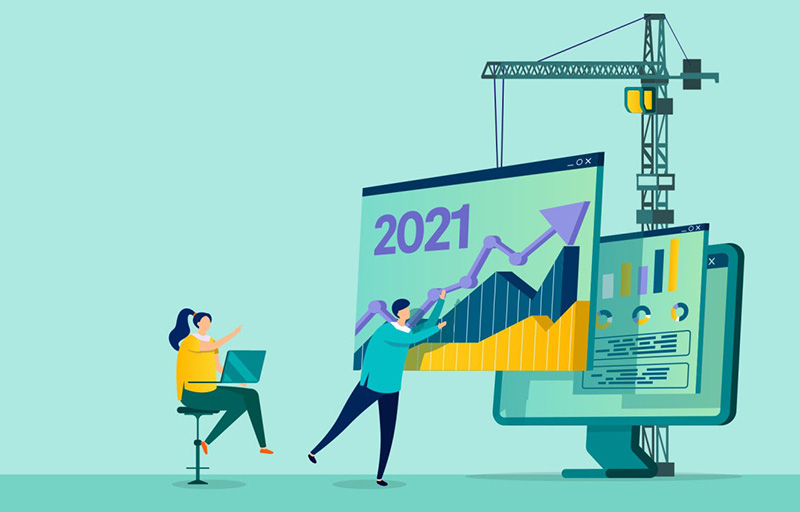
Web Design Statistics to Know in 2021
Web Design Statistics to Know in 2021
Nowadays, running a business is a completely different ballgame, with things like marketing, Search Engine Optimization (SEO), Conversion-Rate Pptimization, and web design to consider. Putting together a unified digital strategy shouldn’t be a guessing game.
We’ve developed a list of vital and vital web-centric data for you to examine in order to assist you cover all bases. Grab a cup of coffee and prepare to be surprised by some figures.
This data will provide you with a more comprehensive vision of the digital landscape in 2021, whether you want to just optimize your present website or construct a completely new platform to expand with your developing business.
Web design Statistics
Following COVID-19, 68 percent of customers said they have considerably greater expectations for organizations’ digital skills.
Because of the worldwide lockdown, most people spent the whole year indoors and mostly online. The tendency of spending more time online and on digital gadgets does not appear to be waning, as many people have grown accustomed to and even depend on them. In fact, 61% of consumers expect to spend more time online after the epidemic.
(Source : Salesforce)
It just takes 50 milliseconds (0.05 seconds) for a visitor to form an opinion about your website and decide whether to remain or depart.
It’s important to make a good first impression, so do your best. Your users are likely to leave your website if it does not resonate with them, or if they find it overwhelming or slow to load. In fact, following a terrible encounter, 88 percent of internet customers are less inclined to return. Millennials and Generation Z, in particular, are less tolerant of poor user experiences.
(Source : Taylor & Francis Online)
If photos take too long to load, 39% of visitors would abandon the site.
People used to have to wait months for pigeon carrier letters, but now they can send a text message in a matter of seconds. It’s logical that Internet consumers are becoming increasingly frustrated.
What is the typical level of patience? According to a survey, if a website takes longer than 3 seconds to load, 53% of mobile users would abandon it. Each year, slow-loading websites cost merchants $2.6 billion in sales. Make sure your website is optimized for speed to stay ahead of the competition.
(Source : Adobe)
Customers look online 81% of the time before making a purchase in a physical store.
Customers want to know if they’re getting a good deal or a good price. Users may access various websites to compare value with only a few clicks. You may be losing prospective customers to your competition if your website is out of date with your current in-store marketing initiatives or new items.
It’s also worth noting that 9.6% of Gen Z customers and 31.4 percent of millennial customers claim they buy in physical stores. If these age groups make up the majority of your target market, it’s even more critical that your website appropriately reflects your brand.
Users will abandon a website if it does not have the company’s contact information, according to 44% of users.
These days, it’s all about being open and honest. Visitors will have more faith in your company’s reliability if they can quickly access your phone number or location. Without this knowledge, it’s more difficult to overcome subconscious fears that your firm is operated in your backyard or overseas, where you may just vanish.
57 percent of internet users said they won’t suggest a company with a mobile website that isn’t well-designed.
A website that isn’t working properly or isn’t pleasant to the eye doesn’t only damage your existing sales. It also limits your business’s development potential by removing organic growth via word-of-mouth recommendations.
2/3rds of people would prefer read something attractively designed than something simple if they had 15 minutes to absorb material.
People are undeniably visually reliant, as vision is the most often used of the five senses. In fact, if the content and style of a website are unappealing, 38 percent of users will abandon it.
Statistics on Usability and User Experience
When there are obvious bullet points, 70% of individuals read through the information, compared to 55% who glance at lists without bullet points. r Statistics on Experience
The importance of content design (headlines and copy) is equal to that of graphic design. It’s pointless to write big paragraphs if they discourage people from reading them. People can scan through your information and attach their attention to the bits that are relevant to them if you break it up into manageable bits.
Sixty-six percent of customers will start and finish an online transaction on several devices.
It’s very common for consumers to come to your website via a short on-the-go Google search, bounce off, and then come back later in bed on their laptop to check you out. It’s more vital than ever to make sure that your online experiences are consistent and smooth across all devices, from mobile to desktop.
The average duration of a webpage session is 2 minutes and 17 seconds.
Isn’t it a little tight for a regular in-person pitch? What is the average session time on your website? You may make your material more interesting and interactive to extend the duration of your sessions.
Statistics for Responsive Mobile Websites
Mobile commerce accounts for 50% of worldwide eCommerce revenue.
Black Friday, Cyber Monday, Click Frenzy, and Thanksgiving Day are examples of viral marketing initiatives that demonstrate the power of mobile marketing. Despite the fact that smartphones and tablets are generally used for surfing, 46.6 percent of smartphone users and 7.7 percent of tablet users completed sales transactions during these sales.
The average consumer spends 70% of their digital media time on a smartphone or tablet.
A significant portion of their screen time is spent on social media platforms, going from Instagram to Facebook to Tik Tok and even their emails. Each of these journey points has sponsored adverts that can route customers to your website. Even if consumers have no intention of making a purchase, it is critical to generate a strong first impression with a genuine responsive website, since a favorable web experience will encourage them to connect with your company.
According to the report, 53% of smartphone users prefer websites and businesses that provide video explanations for products or services.
It’s reasonable that video has become a media mainstay that people are familiar with and enjoy since it dominates most social media newsfeeds. In fact, 45 percent of Internet users watch at least one hour of videos a week on Facebook and/or YouTube. Brands that offer video appear more genuine to their customers.
Share this:

Client’s review for our work satisfaction.


They were great! I had a great experience working with FSM. They redesigned my company website to become a mobile friendly site. They were very responsive, agile and always willing to help. They were also very fast and managed to deliver our website well before the expected deadline.
Michael Solano
CEO - Geotrek Land Surveyor
FSM is an expert IT Company. Franky helped me with my website. He is a careful and attentive listener. I admire his efforts and am pleased with his performance. He gets 5 stars from me. He is unrivaled. Thank you
Richard Rigosa
Realtor
Highly suggested for those looking to increase their online presence at a low cost. We received excellent service and commendable performance in a short period of time for a fraction of the cost. Excellent customer support!
Joan Nami
Entrepreneur
